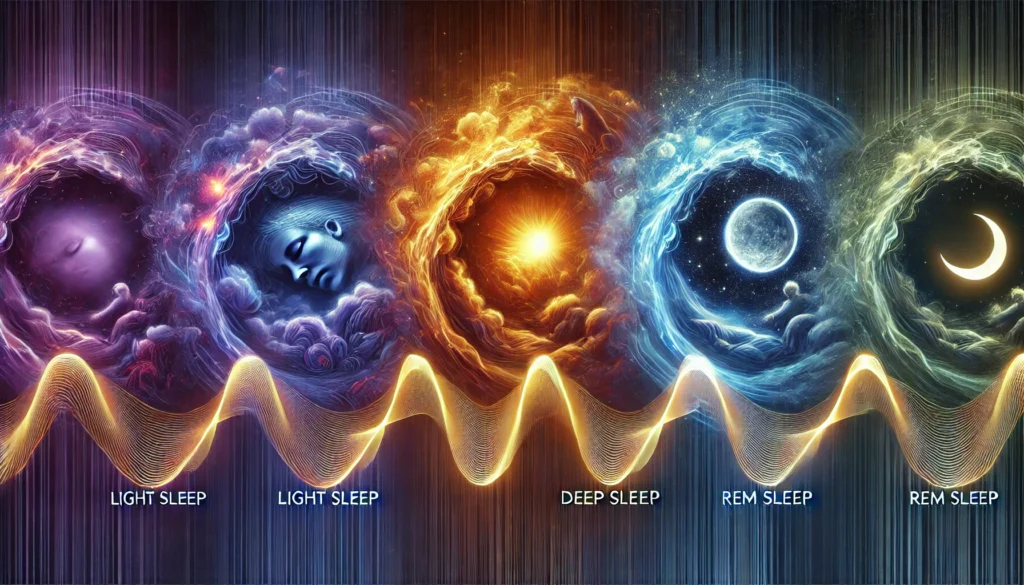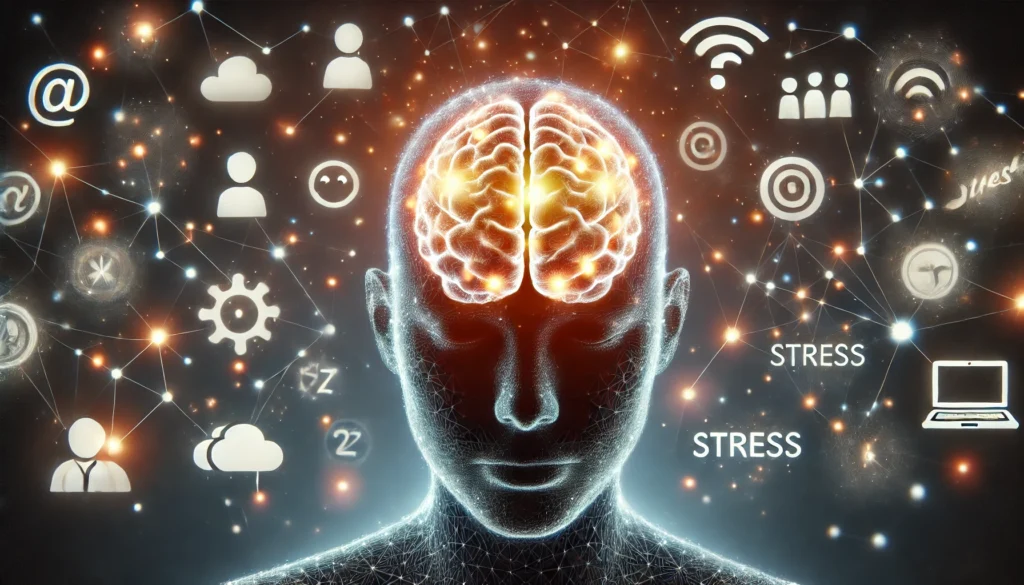In our fast-paced world, achieving a restful night of sleep is often more elusive than it should be. While many focus on the quantity of sleep, the quality of sleep is equally important. A critical component of this quality is the depth of sleep. Shallow sleep, a term that encapsulates non-restorative sleep stages, is increasingly becoming a concern for health and wellness experts, biohackers, and even science journalists. This article aims to provide a comprehensive understanding of shallow sleep, exploring its causes, effects, and potential solutions.
You May Also Like: Understanding the Impact of Chronic Sleep Deficiencies
What Is Shallow Sleep?
Shallow sleep refers to the lighter stages of the sleep cycle, particularly stages 1 and 2 of non-REM sleep. During these stages, the body is not fully at rest, and it is easier to be awakened by external stimuli. While these stages are natural components of the sleep cycle, spending too much time in shallow sleep can be detrimental to overall sleep health.
The Sleep Cycle: A Brief Overview
To understand shallow sleep, it’s essential to grasp the basics of the sleep cycle. Sleep is divided into two primary types: Rapid Eye Movement (REM) sleep and non-REM sleep. Non-REM sleep consists of three stages:
1. Stage 1: The Transition Phase
Stage 1 marks the transition from wakefulness to sleep. During this phase, the brain begins to produce theta waves, which are slower than the alpha waves produced when a person is awake and relaxed. Muscle activity slows, and occasional muscle twitching may occur as the body starts to relax. This stage is brief, lasting only a few minutes, yet it plays a crucial role in bridging consciousness with the deeper stages of sleep.
2. Stage 2: Light Sleep
Stage 2 is characterized by a further slowing of the heart rate and a decrease in body temperature. Brain wave activity slows but is marked by the occurrence of sleep spindles and K-complexes, which are bursts of rapid brain activity. Despite being deeper than stage 1, this stage is still considered shallow sleep. It serves as a preparatory phase, allowing the body to transition into deep sleep, and occupies about 50% of the total sleep cycle.
3. Stages 3 and 4: Deep Sleep
Known as deep or slow-wave sleep, these stages are critical for physical recovery and growth. During these stages, the brain produces delta waves, which are the slowest and most restorative. The body repairs tissues, builds bone and muscle, and strengthens the immune system. These stages are less responsive to external stimuli, making it more challenging to wake up.
The Role of REM Sleep
REM sleep, on the other hand, is vital for cognitive functions such as memory consolidation and dreaming. During REM sleep, the brain is highly active, akin to wakefulness, and most dreaming occurs in this phase. It plays a significant role in emotional regulation and learning, linking experiences to memories.
The Significance of Sleep Architecture
Understanding the architecture of sleep is crucial, as it provides insight into how different stages of sleep contribute to overall health and well-being. A balanced sleep cycle, with adequate deep and REM sleep, ensures that the body and mind rejuvenate effectively. Shallow sleep disrupts this balance, impacting both physical and mental health.

Causes of Shallow Sleep
Several factors can lead to an increased amount of shallow sleep, including:
Lifestyle Factors
- Stress and Its Impact on Sleep
Chronic stress can disrupt the sleep cycle, leading to prolonged periods in shallow sleep stages. The body’s stress response triggers the release of cortisol, a hormone that can interfere with sleep patterns. High stress levels can prevent the transition from light to deep sleep, resulting in fragmented sleep.
- Diet and Exercise
Poor dietary habits, such as consuming caffeine or heavy meals close to bedtime, can affect sleep depth. Caffeine, a stimulant, can hinder the ability to fall into a deep sleep. Similarly, a lack of physical activity can lead to insufficient restorative sleep. Regular exercise promotes deeper sleep by reducing stress and tire the body out physically.
- Circadian Rhythm Disruptions
Irregular sleep schedules and exposure to artificial light can misalign the body’s natural circadian rhythm. This misalignment can result in prolonged periods of shallow sleep, as the body struggles to find a consistent sleep pattern.
Environmental Factors
- Sleep Environment
Noise, light, and temperature can influence sleep quality, often resulting in lighter sleep stages. A noisy or bright room can prevent the transition into deeper sleep stages. Ensuring an ideal sleep environment, with minimal disturbances, is crucial for promoting deeper sleep.
- Technology Use
Exposure to blue light from screens before bedtime can hinder the production of melatonin, a hormone that regulates sleep-wake cycles, leading to shallow sleep. The stimulation from digital devices also keeps the brain alert, delaying the onset of sleep.
- Urban Living
The hustle and bustle of urban life often contribute to sleep disturbances. Constant noise from traffic, nightlife, and other city sounds can make it challenging to achieve deep sleep, as can the prevalence of artificial lighting.
Medical Conditions
- Sleep Disorders
Conditions such as insomnia and sleep apnea are known to disrupt the sleep cycle. Insomnia makes it difficult to fall and stay asleep, often resulting in lighter sleep stages. Sleep apnea, characterized by pauses in breathing, causes frequent awakenings, reducing time spent in restorative sleep.
- Medication
Certain medications can alter the natural progression of the sleep stages, increasing time spent in shallow sleep. Medications for conditions like hypertension, depression, and asthma can have side effects that impact sleep quality, making it difficult to achieve deep, restorative sleep.
- Chronic Health Issues
Chronic pain and other long-term health conditions can interfere with sleep. Pain can prevent the body from relaxing fully, making it harder to reach deeper stages of sleep, while conditions like restless leg syndrome can cause frequent awakenings during the night.
The Effects of Shallow Sleep
The repercussions of shallow sleep extend far beyond just feeling tired the next day. Here are some of the critical effects:
Cognitive Impairments
Shallow sleep can lead to reduced cognitive function, impacting memory, attention, and decision-making skills. The brain relies on deep sleep stages for memory consolidation, and without it, information retention is compromised. Over time, chronic shallow sleep can contribute to neurodegenerative diseases such as Alzheimer’s, as the brain fails to clear out toxins effectively.
- Impact on Learning and Memory
Deep sleep plays a crucial role in processing and storing new information. Without sufficient deep sleep, the brain’s ability to consolidate memories weakens, making learning new skills and recalling information more challenging.
- Attention and Focus
Individuals experiencing shallow sleep often find it hard to concentrate on tasks. The lack of restorative sleep affects the brain’s ability to focus, resulting in reduced productivity and increased errors.
- Long-term Cognitive Health
Over time, chronic shallow sleep can contribute to neurodegenerative diseases such as Alzheimer’s. The brain’s glymphatic system, responsible for clearing waste products, operates efficiently during deep sleep. Without it, harmful proteins can accumulate, increasing the risk of cognitive decline.
Mood Disturbances
A lack of deep sleep can result in mood swings, irritability, and increased susceptibility to stress and anxiety. Emotional regulation is closely linked to sleep quality, and without sufficient restorative sleep, individuals may experience heightened emotional responses. Depression can also be exacerbated by poor sleep quality, as disrupted sleep patterns influence neurotransmitter balance.
- Emotional Regulation
Deep sleep is essential for processing emotions. Without it, individuals may find themselves more sensitive to stressors, leading to anxiety and irritability.
- Depression and Anxiety
Poor sleep quality is both a symptom and a contributor to mental health disorders like depression and anxiety. Shallow sleep can exacerbate these conditions by disrupting the balance of neurotransmitters in the brain.
- Social Interactions
Mood disturbances caused by shallow sleep can affect social relationships. Irritability and emotional instability can lead to conflicts and misunderstandings in personal and professional interactions.
Physical Health Consequences
Shallow sleep affects the body’s ability to repair and rejuvenate, leading to a weakened immune system, increased inflammation, and a higher risk of chronic conditions such as cardiovascular disease and obesity. During deep sleep, the body releases growth hormones necessary for tissue repair and muscle growth.
- Immune Function
The immune system relies on deep sleep to function optimally. A lack of restorative sleep weakens the body’s defenses, making it more susceptible to infections and illnesses.
- Inflammation and Chronic Illness
Chronic shallow sleep contributes to systemic inflammation, which is linked to various health problems, including cardiovascular disease and diabetes. Inflammation can damage blood vessels and lead to plaque buildup, increasing the risk of heart disease.
- Weight Management
Shallow sleep disrupts the balance of hunger-regulating hormones, leading to increased appetite and weight gain. Insufficient sleep can reduce leptin levels, the hormone responsible for signaling fullness, while increasing ghrelin levels, which stimulates hunger.

Strategies to Mitigate Shallow Sleep
While shallow sleep can be detrimental, several strategies can help improve sleep depth and overall sleep quality:
Optimize Sleep Environment
Creating a conducive sleep environment can significantly impact sleep quality. Ensure your bedroom is dark, quiet, and cool. Consider using blackout curtains, earplugs, or white noise machines to minimize disruptions.
- Lighting and Ambience
Soft, warm lighting in the evening can help signal to your body that it’s time to wind down. Avoid bright lights, which can interfere with melatonin production, and consider using dimmable lights or lamps with red-tinted bulbs.
- Comfort and Bedding
Investing in a comfortable mattress and pillows can significantly improve sleep quality. Choose bedding materials that regulate temperature and provide support, ensuring a restful night’s sleep.
- Reducing Noise Pollution
Noise can be a significant disruptor of sleep. Using soundproof curtains or a white noise machine can help drown out background noise, creating a peaceful sleep environment.
Establish a Sleep Routine
Consistency is key to healthy sleep patterns. Establish a regular sleep schedule by going to bed and waking up at the same time every day, even on weekends. Incorporate relaxing bedtime rituals, such as reading or taking a warm bath.
- Pre-Sleep Rituals
Engaging in calming activities before bed can signal to your body that it’s time to sleep. Consider practices like meditation, gentle yoga, or listening to soothing music to relax your mind.
Reducing screen time before bed can improve sleep quality. The blue light emitted by screens can interfere with melatonin production, so aim to power down devices at least an hour before bedtime.
- Sleep Diary
Keeping a sleep diary can help identify patterns or habits that may be affecting sleep. Track your sleep schedule, bedtime routines, and how you feel upon waking to make informed adjustments.
Limit Stimulants
Avoid caffeine and nicotine close to bedtime, as they can interfere with sleep quality. Instead, opt for calming herbal teas like chamomile or valerian root.
- Awareness of Hidden Caffeine Sources
Be mindful of foods and drinks that contain hidden caffeine, such as chocolate and certain medications. Being aware of these sources can help reduce unintended caffeine intake.
- Alternatives to Stimulants
Herbal teas like chamomile or valerian root can promote relaxation without the stimulating effects of caffeine. Incorporating these into your evening routine can help ease the transition to sleep.
- Timing of Meals
Eating large meals before bedtime can disrupt sleep. Aim to have dinner at least a few hours before bed, and opt for light, sleep-friendly snacks if needed.
Embrace Technology Wisely
While technology can be a sleep disruptor, it can also be a helpful ally. Use sleep tracking apps to monitor your sleep patterns and identify areas for improvement. Additionally, consider devices that emit red light, which can be less disruptive to melatonin production.
- Sleep Tracking and Analysis
Using apps and wearable devices to track sleep can provide valuable insights into your sleep patterns. Analyzing this data can help identify areas for improvement, such as adjusting bedtime or identifying stressors that affect sleep.
- Mindful Use of Sleep Technology
While technology offers tools for improving sleep, it’s essential to use them mindfully. Avoid over-relying on gadgets, and focus on developing healthy sleep habits that don’t depend solely on technology.
- Red Light Devices
Consider using red light devices in the evening, as they are less likely to disrupt melatonin production compared to blue light. This can help prepare your body for sleep and promote a smoother transition into rest.
Future Implications and Research
The field of sleep research is continually evolving, with new insights shedding light on the complexities of shallow sleep. As technology advances, biohackers and health professionals are exploring innovative ways to optimize sleep. For instance, wearable devices that track sleep stages and provide real-time feedback are becoming increasingly popular.
Technological Advancements in Sleep Science
The use of technology in sleep research has opened new avenues for understanding sleep patterns and disorders. Wearable devices, such as smartwatches and fitness trackers, offer real-time data that can help individuals tailor their sleep habits for optimal health.
- Wearable Sleep Devices
These devices monitor sleep stages, heart rate, and movement, providing users with insights into their sleep patterns. This data can help identify issues such as frequent awakenings or lack of deep sleep.
- Smart Home Integrations
Smart home technology is increasingly being used to create optimal sleep environments. From automated lighting systems that adjust based on the time of day to smart beds that monitor sleep quality, these innovations offer personalized solutions for better sleep.
- AI and Sleep Research
Artificial Intelligence is playing a significant role in analyzing sleep data. AI algorithms can detect patterns and provide personalized recommendations, aiding in the development of targeted sleep interventions.
Genetic and Neurological Insights
Understanding the genetic and neurological underpinnings of sleep can pave the way for personalized sleep interventions, offering tailored solutions to improve sleep quality.
- Genetic Factors
Research into the genetic components of sleep is uncovering how specific genes influence sleep patterns and disorders. This knowledge could lead to personalized treatments based on an individual’s genetic makeup.
- Neurological Pathways
Studying the brain’s role in sleep regulation can help identify the neurological pathways involved in sleep disorders. This understanding can lead to the development of new therapies targeting these pathways to improve sleep quality.
- Customized Sleep Solutions
As research progresses, the potential for customized sleep solutions becomes more feasible. Tailored interventions, based on genetic and neurological insights, could offer more effective treatments for sleep disorders.
The Role of Lifestyle Medicine
Lifestyle medicine emphasizes the importance of healthy behaviors in preventing and managing sleep disorders. By focusing on lifestyle changes, individuals can improve sleep quality without relying solely on medication.
- Holistic Approaches
Integrating lifestyle medicine into sleep health involves addressing factors such as diet, exercise, and stress management. These holistic approaches can lead to more sustainable improvements in sleep quality.
- Behavioral Interventions
Cognitive-behavioral therapy for insomnia (CBT-I) is an effective non-pharmacological treatment for sleep disorders. It focuses on changing behaviors and thoughts that affect sleep, offering a long-term solution to sleep problems.
- Community Education and Support
Raising awareness about the importance of sleep and providing community support can empower individuals to make informed choices about their sleep habits. Educational programs and support groups can play a vital role in promoting better sleep health.

Conclusion
Shallow sleep may often be overlooked, but its impact on health and well-being is profound. By understanding its causes and effects, and by implementing targeted strategies to improve sleep depth, individuals can significantly enhance their overall sleep health. As research continues to unlock the mysteries of sleep, the potential for optimizing this vital aspect of life becomes ever more promising. Whether you are a health coach, science journalist, or biohacker, the pursuit of better sleep is a journey worth undertaking. The future of sleep health holds exciting possibilities, with advancements in technology and science paving the way for more personalized and effective sleep solutions.
Further Reading:
4 Signs You Might Have Sleep Apnea
Light Sleeper: What It Means and What To Do About It
Important Note: The information contained in this article is for general informational purposes only, and should not be construed as health or medical advice, nor is it intended to diagnose, prevent, treat, or cure any disease or health condition. Before embarking on any diet, fitness regimen, or program of nutritional supplementation, it is advisable to consult your healthcare professional in order to determine its safety and probable efficacy in terms of your individual state of health.
Regarding Nutritional Supplements Or Other Non-Prescription Health Products: If any nutritional supplements or other non-prescription health products are mentioned in the foregoing article, any claims or statements made about them have not been evaluated by the U.S. Food and Drug Administration, and such nutritional supplements or other health products are not intended to diagnose, treat, cure, or prevent any disease.


